By: Lance Van Auken
As I write this, I’m sipping coffee in a comfy Airbnb in Greater London, in a town called Earlsfield, which is near Wimbledon. We (my wife Robin and I) arrived here a little over a week ago. She works from anyplace with good wifi, and I’m recently retired.
We flew Virgin Atlantic out of JFK Airport in New York City, instead of making the Atlantic crossing via Cunard’s Queen Mary 2 as originally planned. Cunard canceled that trip because they needed more time to get the liner ready. So now, the plan is to take the QM2 back to the states when our extended trip to England ends in mid-February.

Having an American Express Platinum card means we have access to Centurion Lounges throughout larger airports worldwide, as well as other lounges. This is Robin at the Centurion Lounge at JFK Airport in New York City. If you’re traveling even a few times a year, this perk alone can more than make up for the annual fee. A decent meal, along with drinks (including alcohol) are free. You can access the lounge within three hours of your flight time, unless you are between flights, in which case you can stay longer.
I can’t say the process for getting to this point was easy. Parts of it were easy, mind you, like booking the Airbnbs. We did that months ago.
But as our departure date approached, the pandemic surged again. Fortunately, there were measures in place to allow travel to go on, albeit with some headaches.
The United Kingdom increased efforts to prevent the virus from spreading by requiring two Covid tests for those traveling from the US and elsewhere. The trick was, the first test had to be taken and negative results received within two days before boarding the flight.
The UK also had us fill out an online locator form, which helps the government trace infections and mitigate them. The form had to be completed within two days of departure, and had to list the booking number for a second test in the U.K.
Robin’s result came in about 24 hours after the test was administered. Mine, however, took a full 48 hours—making for some anxious moments on departure day. I actually had booked a last-minute rapid test in the JFK Airport to ensure I could get on the flight when my negative result came in about five hours before our boarding time. That test would have been very expensive, so fortunately we were able to cancel it without charge.
It’s easier, by the way, if you’re fully vaccinated. There are more hoops to jump through, and longer quarantine times, for those not fully vaccinated (e.g., medically unable to be vaccinated—or a bigger fan of Facebook than science, reason, and intelligence).
The flight was excellent. We’ve never flown Virgin Atlantic, so we were impressed by the friendly crew and decent meal (and free wine). We splurged for seats with a little more legroom, which was definitely worth it.
Our flight left JFK a bit later than its scheduled time of 6:15pm, but only because we were held up by favorable winds. Heathrow Airport outside of London doesn’t wake up until 6am, so our helpful and informative pilot explained we could not leave until the ground crew was available on the other end.
It’s funny how delays are easier to accept that way. I wonder—if all US domestic flight announcements came through some sort of filter that adds a posh English accent, there might be fewer incidents of mid-air craziness?
I might have nodded off a couple of times during the flight, as did Robin. But I’ve never been able to sleep much on a plane, and the excitement of flying to England kept me wide-eyed for the most part. It took a few days to become adjusted to the time change, which is five hours ahead of Eastern Time in the US. So in our case, we landed in England at 6am local time, when our bodies were telling us it was about 1am.
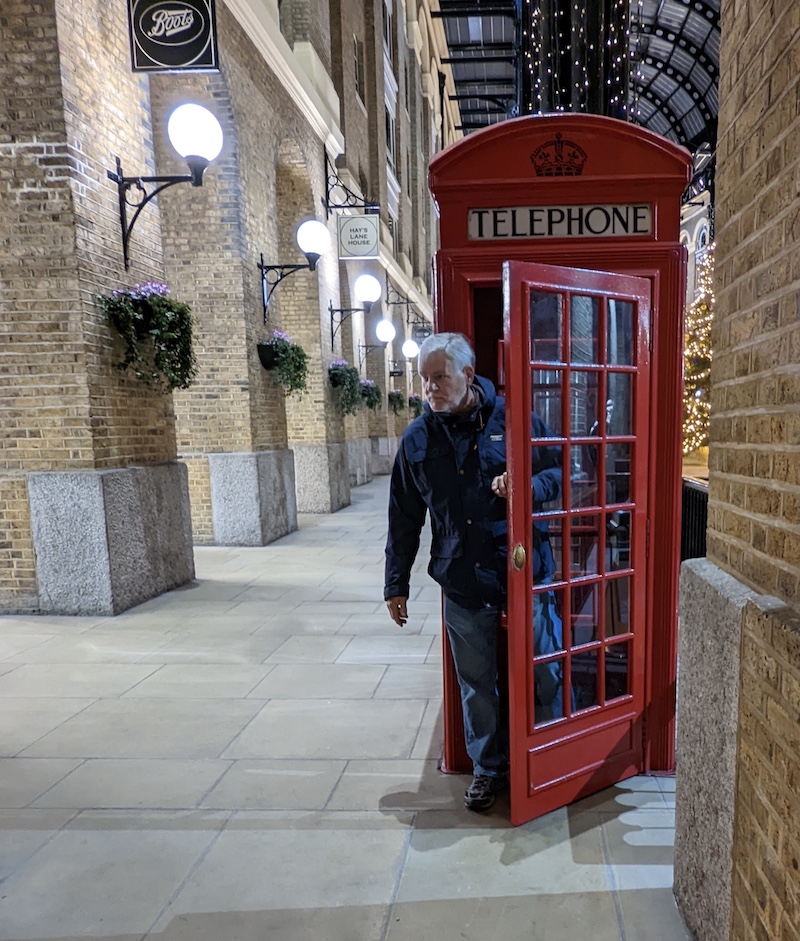
It’s an obligatory photo for any American traveling to London. Red phone booths can still be found here and there, and the oldest ones are sort of mini tourist attractions. With the ubiquity of personal phones, some red phone booths have been converted to defibrillator boxes.
I should add that we were looking forward to using our snazzy new phones in the UK. The salespersons where we bought them assured us, when we explained we’d be traveling to the UK in a couple of weeks, that we’d be able to use a different SIM card in them, avoiding ridiculous charges for roaming.
(I won’t say what carrier we have, but it rhymes with shmerizon.)
However, a “shmerizon” rep told us by phone, just before we left, that our devices could not be unlocked until 60 days after purchase, unless we forfeited the trade-in offer we received for our old phones. He said it was “to prevent fraud.”
Ha!
I am reasonably sure that somewhere in the multiple pages of agreement papers we signed, we agreed to this. Still, I wrote a hotly-worded letter to “shmerizon,” detailing my great dissatisfaction, and accusing them of running a scam. It was an awesome letter. Anyone in power who read it would immediately call for a corporate review of best practices.
Instead, I now imagine my letter was read aloud in a dark-paneled penthouse meeting room where men who look like Mr. Bumble, the beadle in Oliver Twist, slump into stoutly padded chairs around a mahogany table littered with empty caviar dishes and little spoons. There, they light cigars with the $100 bills we send them every month, and sip expensive liquor from crystal tumblers.
One of them says, “Listen to this, another complaint from a naughty cell phone user, which nobody can love.”
Or not. My letter elicited no response, of course. If any human eyes besides mine saw it, they probably belonged to someone no more capable of making good our complaints than the fellow who sold us the phones in the first place.
Apologies to Mr. Dickens. Moving on.
Instead, we bought two smart phones, with unlimited data, at the Sim Local kiosk near baggage claim at Heathrow Airport. The salesperson there was extremely helpful, probably deserves a raise, and she didn’t send us on our way until both of our new phones were working correctly.
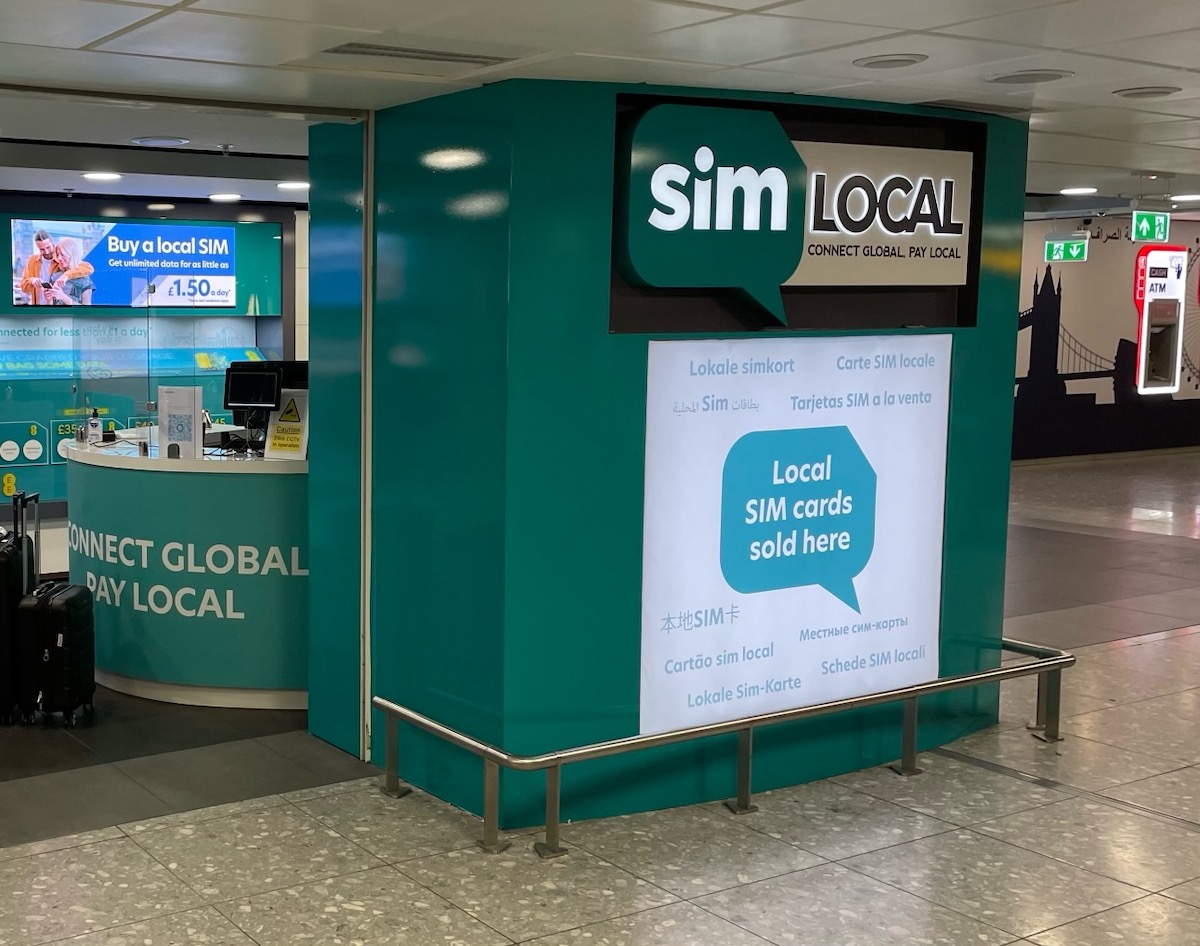
An affordable alternative to ridiculous roaming charges is to buy a SIM card and have it installed in your phone by the helpful folks at Sim Local, conveniently located near baggage claim at Heathrow Airport. There are several data packages available, but you must have an unlocked phone for the card to work.
We’ve turned off cell data for our “shmerizon” phones, using them only when we have wifi coverage. Problem solved, and “shmerizon” gets fewer of our $100 bills. That’ll show ‘em.
Once we got back on the grid, the next step was our second Covid test—a mandatory PCR version. That happened outside the Heathrow Terminal 3 baggage claim in what seemed to be a hastily-arranged room. We waited in line for about 20 minutes outside (it was officially “cold” as measured on the Celsius scale), then inside for another 20 minutes before being swabbed and sent on our way to London’s famous Underground rail network.
Looking like the lost Americans we are, Londoners—both official workers on the Transport for London (TfL) system, and random people—were extremely helpful in getting us on the right trains. We arrived at our Airbnb about four hours after landing, which didn’t seem too bad.

Often confused by visitors from abroad as London Bridge (which is about a half-mile upstream and just looks like any other bridge), Tower Bridge was completed in 1894. A bascule bridge, it was designed to blend in with the nearby Tower of London, which was begun by William the Conqueror in the 11th century.
Our Airbnb host, Amanda, met us upon arrival and showed us around a bit before she departed for her own holiday in Greece. We rented an entire house in Earlsfield, a few miles southwest of London’s big attractions. It’s perfect for us, with a kitchen, 2.5 baths, and three bedrooms, perfect to accommodate a guest coming to visit later in this trip.
The Airbnb is far less expensive than a hotel room—if you could ever find a hotel room with a kitchen and multiple baths and bedrooms for less than $1,000 a night. We have this place to ourselves for about $100 a night for the whole month. The place is spotless, warm, and comfortable.

This is the lovely garden area of our Airbnb home in the London suburb of Earlsfield. It’s a perfect location, quiet, and within eight minutes walking time of a train station. The train from that station to Waterloo Station (which is just a couple of minutes from the River Thames and many of the sights) takes only about 16 minutes.
Our house is only a few minutes’ walk to the Earlsfield train station, where we each use a TfL Oyster Card to get to just about everywhere we’d like to go. We have our cards topped off at a set amount, using a linked credit card.
Also, we don’t have to keep track of which zone we’re in, as with some of the other options. The Transport for London system keeps track of all our trips, and gives us credits when we exceed the full fare levels per day/week. We are able to monitor it each day online. Also, each time we tap in or out of a turnstile, the readout shows how many British Pounds are left on the card. Easy peasy.
TIP: Don’t forget to tap the Oyster card on the way out of each stop on the subway stations/trains, even if the gates are open. If not, you’ll be charged a full fare through all zones on that train. For buses, you only need to tap in, since the fare is roughly £2 for each bus ride, regardless of the number of stops.
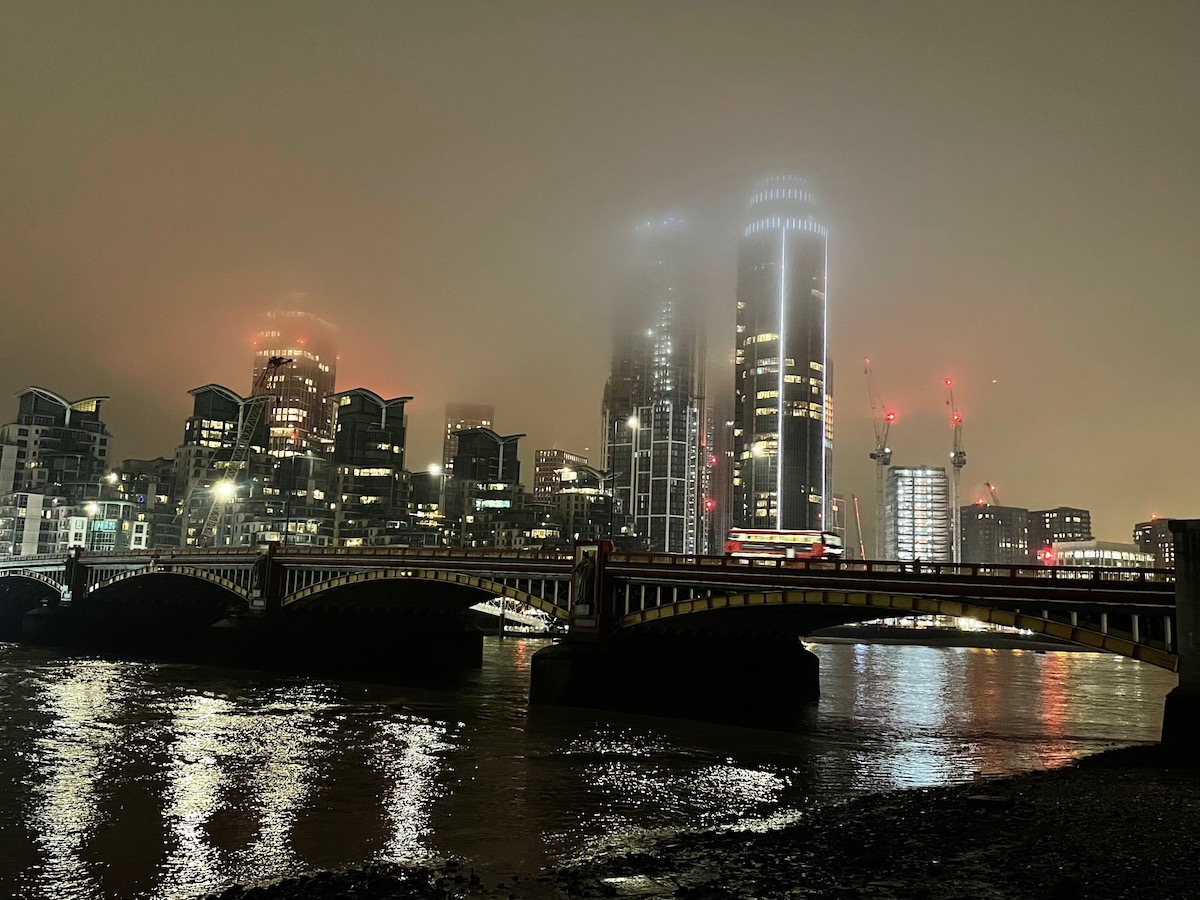
The buildings behind Vauxhall Bridge are shrouded in fog. Gone are the days of “pea soupers” that choked London frequently—a result of weather factors and the use of coal to heat homes and make electricity. Coal is being phased out for both purposes, and now accounts for less than 2 percent of the electricity generation, compared to 40 percent just 10 years ago.
In the first week (after quarantining for 24 hours until our negative test results were received from our second Covid test), we’ve been to: the South Bank of the Thames for a nice walk and Christmas market visit; the Royal Botanic Gardens, Kew, to see one of the most biodiverse places on Earth; the Tate Britain museum; and a performance of “Handel’s Messiah” at Royal Albert Hall. All that travel via the railways and tube has cost us only about £16 each.
Each of these I’d highly recommend. We have more destinations planned, so I’ll cover those in another post.
So far it’s been a great trip, all things considered. Cheery bye!
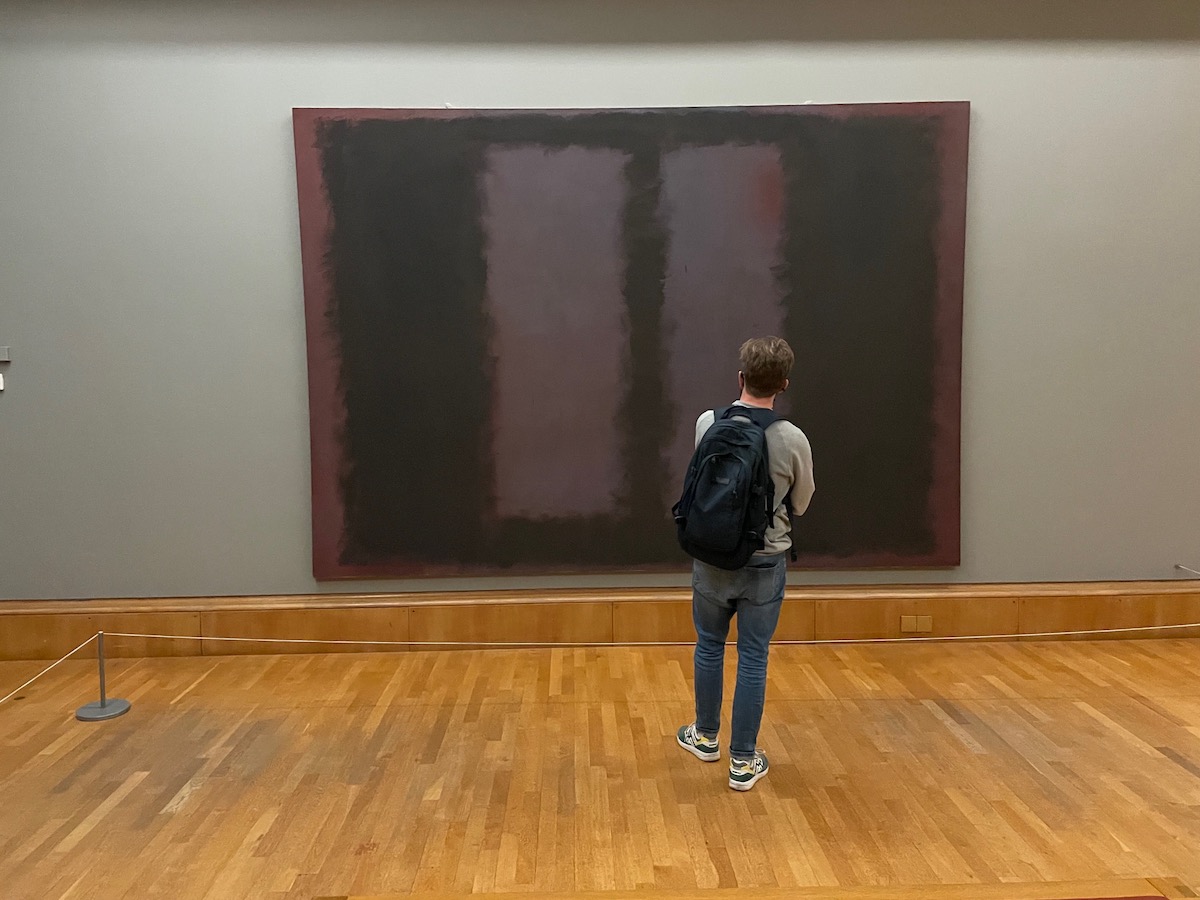
The Tate Britain museum is one of many outstanding art museums in London. This gallery exhibits some of the most well-known works of abstract artist Mark Rothko. The gallery features the Seagram Murals, originally commissioned for the Four Seasons restaurant in the Seagrams Building in New York City. Rothko intended the paintings to sicken the restaurant’s patrons, but he returned the commission, withdrew the paintings, and some of them ended up at the Tate Britain.
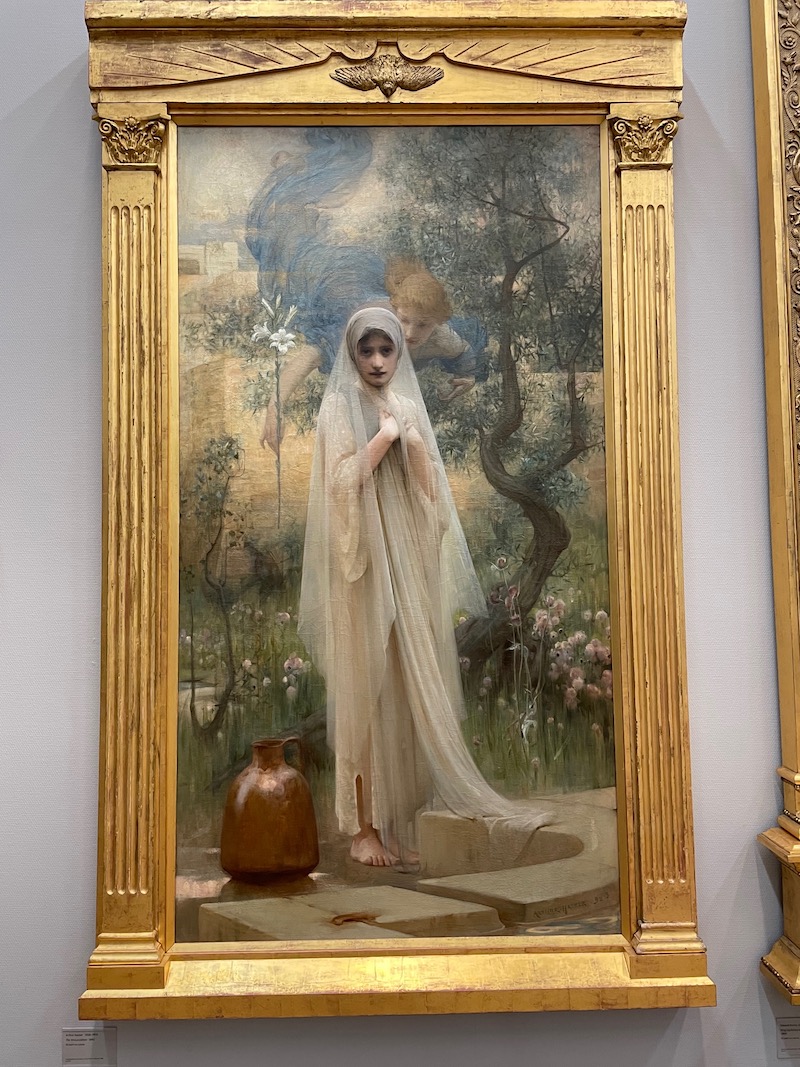
This is The Annunciation, by Arthur Hacker (1892), depicting the Christian story of the moment an angel informed Mary that the child she was not yet carrying would be a savior, and she should name him Jesus. Whether or not one believes the story, zoom in to read the artist’s effort to portray Mary’s overwhelming emotions at the news. More recently, infrared photography of this painting shows it once included a woman wearing a red headscarf seated behind Mary.
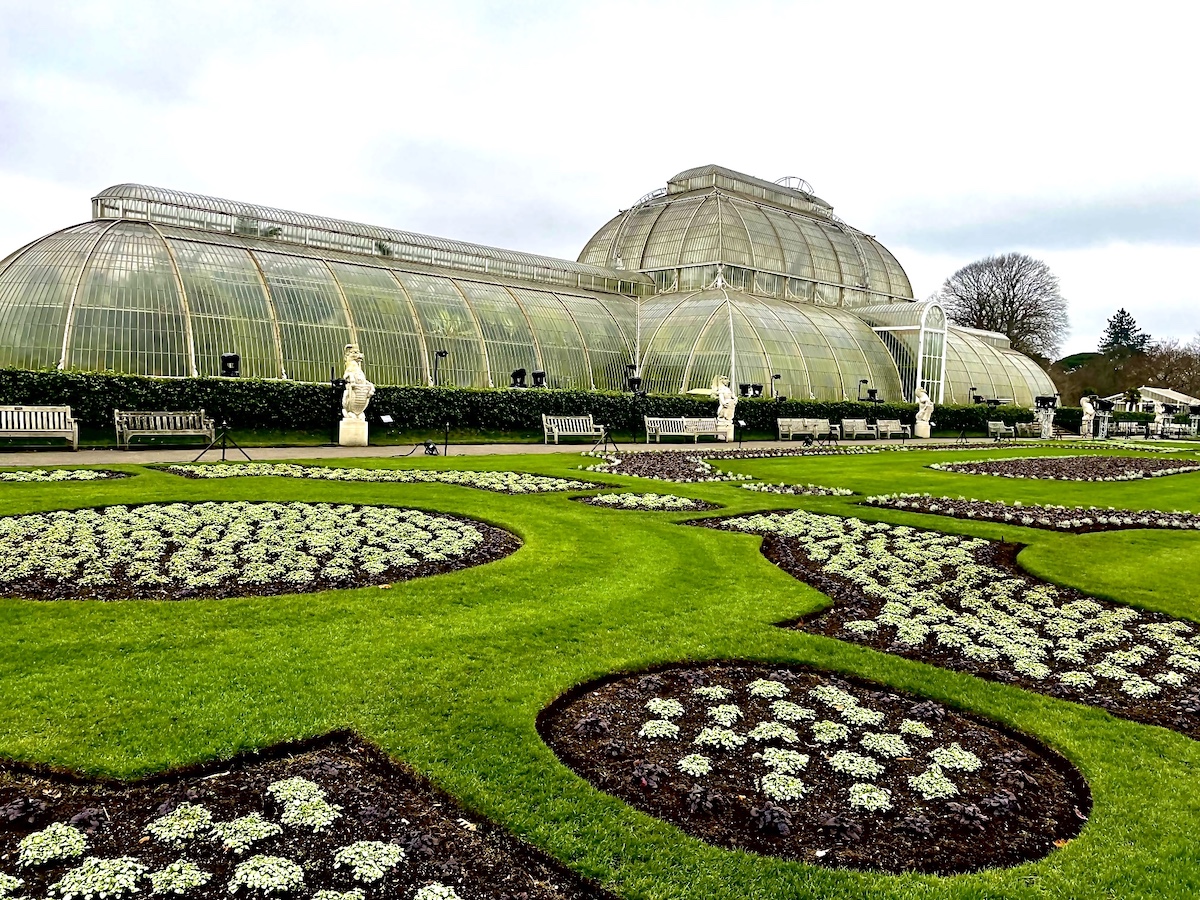
Kew Gardens (officially, Royal Botanic Gardens, Kew) houses thousands of varieties of examples of flora from around the world. Begun as a collection in 1762, it is considered one of the most diverse places, from a botanical point of view, on the planet. More than a million people a year visit. This photo shows the Palm House, just one of many structures on the site.
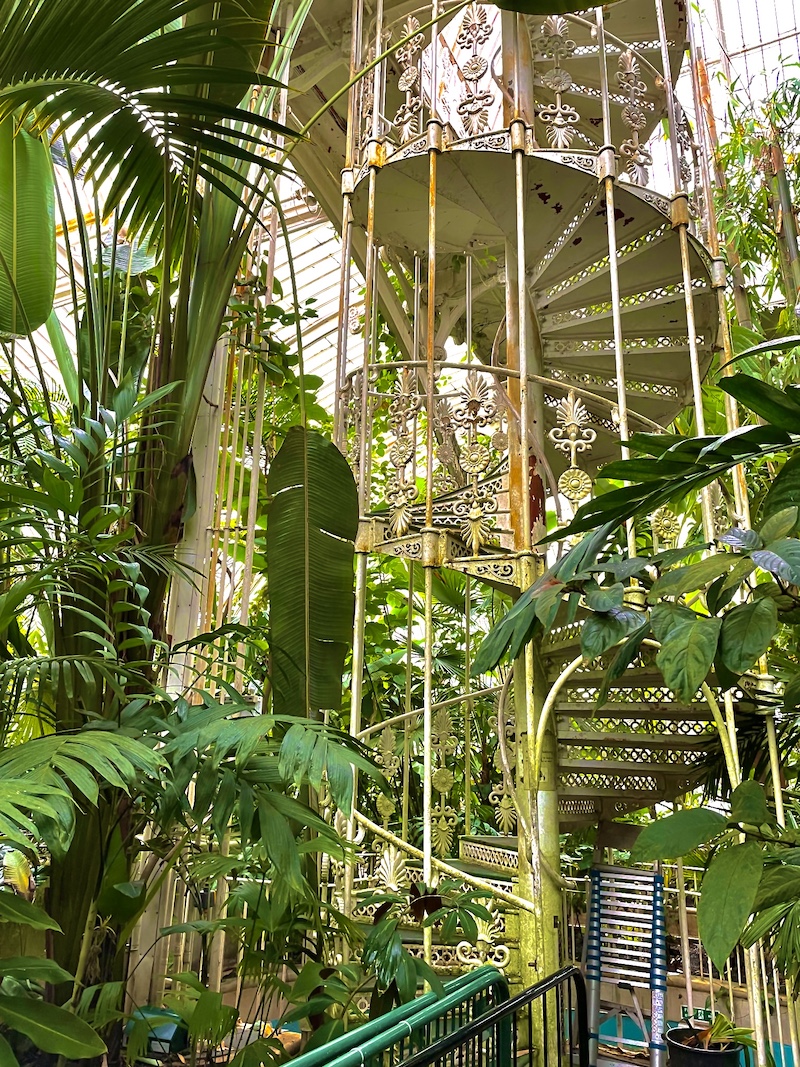
Inside the Palm House, it’s a nice respite on a winter’s day, though decidedly muggy. The Palm House was completed in 1848, and features specimens from the Americas, Asia, and Africa.
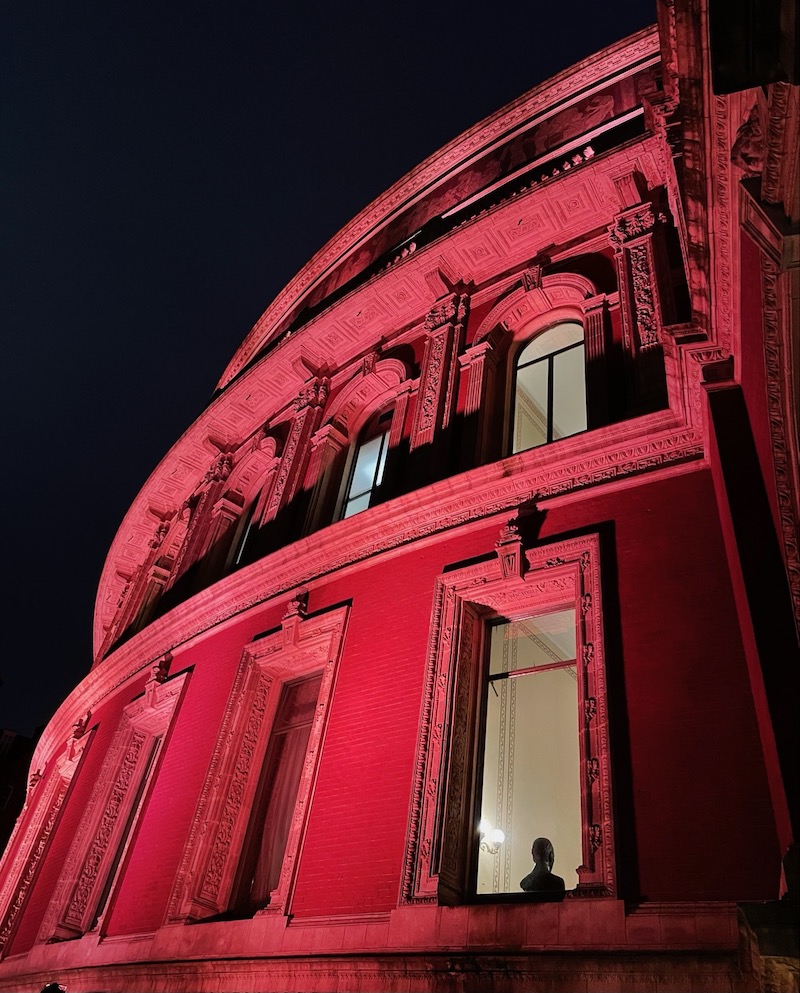
Built 150 years ago, and named to honor Queen Victoria’s late husband Prince Albert, Royal Albert Hall in London is one of the city’s great landmarks. It has seen performances or presentations by Richard Wagner, Albert Einstein, and Sir Winston Churchill, among the thousands of events held there.

Our visit to Royal Albert Hall was for the annual performance of Handel’s Messiah. This photo is just before the event began, as the orchestra was gathering on stage.
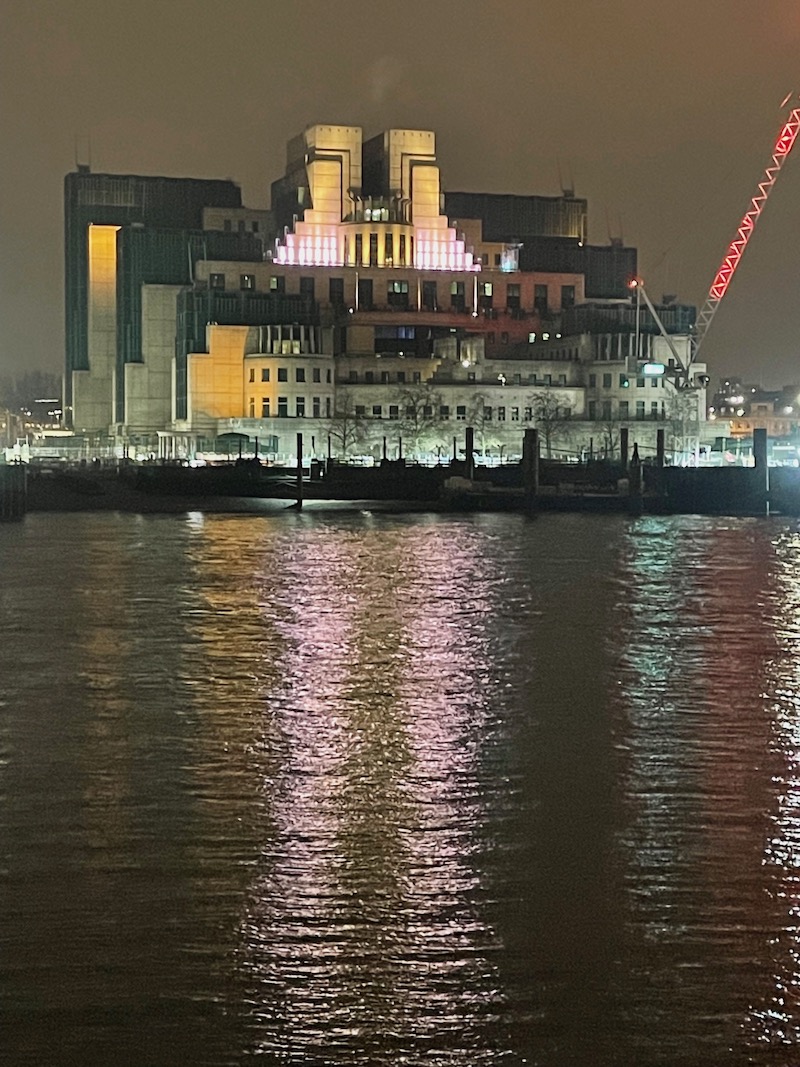
Looking ominous at night from the north bank of the Thames is MI6 headquarters. MI6, which moved into this place in Vauxhall in 1994, is the U.K. version of the CIA in the US. We didn’t see any James Bond types.
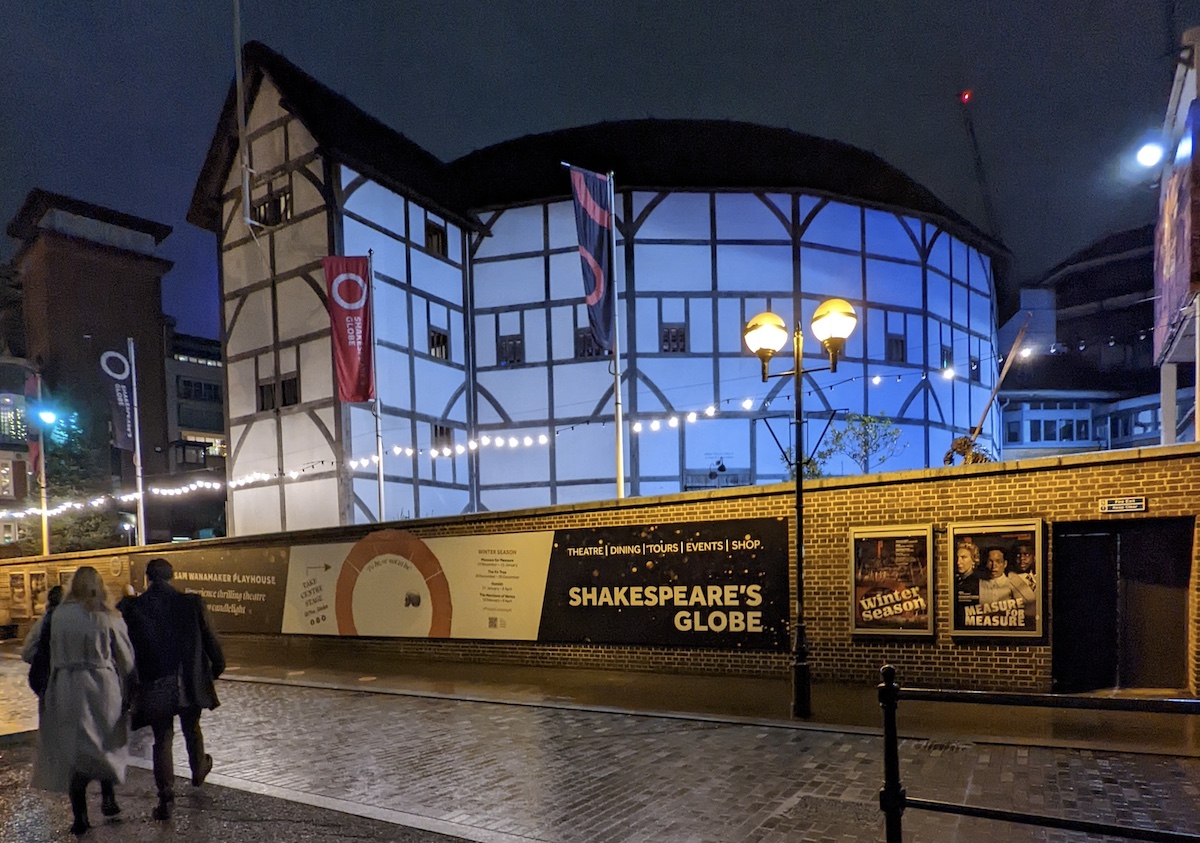
We hope to be able to see a play here before we leave. It’s a reconstruction of the Globe, for which William Shakespeare wrote many plays. This version was opened in 1997, and recreates the look and feel of the original, complete with open air seating on hard benches. Also on site is the Sam Wanamaker Playhouse, with a roof for the winter season.
About the Author
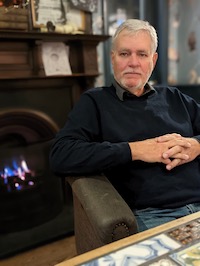 Lance Van Auken retired in 2020 from Little League Baseball and Softball in Williamsport, PA, where he served as Vice President. While at Little League, he was liaison to The White House during President George W. Bush’s Tee Ball on the South Lawn initiative. As spokesman for Little League, he has been interviewed on the Today Show, Good Morning America, ESPN, MSNBC, PBS, and in hundreds of newspapers. Lance also served for 12 years in the U.S. Army Reserve as a Military Policeman and Journalist. He now enjoys traveling with his wife, Robin, and writing about it. Oh, and golf. He likes golf, but isn’t very good at it.
Lance Van Auken retired in 2020 from Little League Baseball and Softball in Williamsport, PA, where he served as Vice President. While at Little League, he was liaison to The White House during President George W. Bush’s Tee Ball on the South Lawn initiative. As spokesman for Little League, he has been interviewed on the Today Show, Good Morning America, ESPN, MSNBC, PBS, and in hundreds of newspapers. Lance also served for 12 years in the U.S. Army Reserve as a Military Policeman and Journalist. He now enjoys traveling with his wife, Robin, and writing about it. Oh, and golf. He likes golf, but isn’t very good at it.
Frayed Passport is a participant in the Amazon Associates Program, an affiliate advertising program designed to provide a means for sites to earn advertising fees by advertising and linking to Amazon.com. We also may share links to other affiliates and sponsors in articles across our website. If you have questions or concerns, please contact us.

